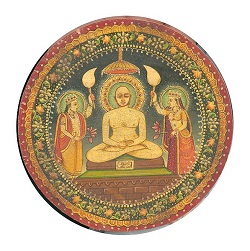|
TRANSLATE THIS ARTICLE
Integral World: Exploring Theories of Everything
An independent forum for a critical discussion of the integral philosophy of Ken Wilber
 Andrea Diem-Lane is a tenured Professor of Philosophy at Mt. San Antonio College, where she has been teaching since 1991. Professor Diem has published several scholarly books and articles, including The Gnostic Mystery and When Gods Decay. She is married to Dr. David Lane, with whom she has two children, Shaun-Michael and Kelly-Joseph. Andrea Diem-Lane is a tenured Professor of Philosophy at Mt. San Antonio College, where she has been teaching since 1991. Professor Diem has published several scholarly books and articles, including The Gnostic Mystery and When Gods Decay. She is married to Dr. David Lane, with whom she has two children, Shaun-Michael and Kelly-Joseph. AnekantavadaThe Jain Version of Multiple World ViewsAndrea Diem-LaneAnekantavada (literally “not one sided”) is one of the most profound and insightful concepts ever developed in the history of ideas and traces its origin back some 2600 years ago to the ancient religion of Jainism in India. Anekantavada, though sometimes postulated as an intellectual extension of the Jain concept of ahimsa, or non-violence, is perhaps best understood as a process of seeing any person or event from multiple angles and not closing one’s self off from contrarian perspectives. Some have even argued that anekantavada is a philosophical talisman to ward off dogmatic thinking or myopic fundamentalism. A beautiful illustration of the concept is captured in Jain literature by the story of six blind men and an elephant. By accessing different parts of the elephant’s body, each blind man tries to deduce what he is touching. The blind man who feels a leg says the elephant is like a pillar; the one who feels the tail says the elephant is like a rope; the one who feels the trunk says the elephant is like a tree branch; the one who feels the ear says the elephant is like a hand fan; the one who feels the belly says the elephant is like a wall; and the one who feels the tusk says the elephant is like a solid pipe. A king explains to them: All of you are right. The reason every one of you is telling it differently is because each one of you touched the different part of the elephant. So, actually the elephant has all the features you mentioned.  Mahavira employed anekanta extensively to explain the Jain philosophical concepts (painting from Rajasthan, ca. 1900) Interestingly, anekantavada is not a concept exclusive to Jainism since it has appeared in various ways throughout human history. We find the idea sprinkled throughout literature, and it is the central theme in Tolstoy’s famous short story, The Coffee House of Surat. Set in India, various individuals from different religious and cultural background debate the existence of God and his nature. There is a Persian, an African slave, a Brahmin, a Jew, an Italian, a Protestant minister, a Turk, and finally a whole host of others from differing faiths. As Tolstoy recounts, “but by this time a great dispute had arisen among all the strangers of different faiths and creeds present. There were Abyssinian Christians, Llamas from Thibet, Ismailites and Fire-worshippers. They all argued about the nature of God and how He should be worshipped. Each of them asserted that in his country alone was the true God known and rightly worshipped. Every one argued and shouted.” Tolstoy resolves the story with a Chinaman who argues for an acceptance of a multiplicity of views, arguing that the God they seek transcends human pettiness and political nation-states. Concludes Tolstoy, “So spoke the Chinaman, the student of Confucius; and all who were present in the coffeehouse were silent, and they disputed no more as to whose faith was the best.” The implications of Anekantavada are also present in celebrated international films, such as the Japanese classic Rashomon, The plot involves the death of a samurai and each character in the movie recounts a different version of what transpired, although each of their perspectives is tainted by being self-serving. There is the wife’s story, the bandit’s story, the samurai’s story, and the woodcutter’s story. Multiple perspectives but none contain the full story or the whole truth. One of the best examples of anekantavada is found in science, which is predicated upon the acceptance of multiple viewpoints with the desired aim of allowing each to compete with each other to discover which one best explains the given phenomenon. But even when one viewpoint holds sway, the scientist must continually be open to being wrong. This very modus operandi (of allowing contrasting models) is precisely why science has been so successful and why it has been incredibly progressive in developing new and powerful technologies. Edward O. Wilson underlines this spirit of multiple worldviews and its apparent unity in his controversial book, Consilience: The Unity of Knowledge, where he contends that each academic discipline should be considered and reconciled when examining complex issues. Ken Wilber postulates something similar to Consilience, but discarding more of its radical reductionisms, by championing an Integral Paradigm that incorporates an AQAL (all quadrants, all levels) inclusivity which is sometimes explained more simply as “everyone is right.” What makes the Jain doctrine so powerful is not that it relativizes all religious claims, but rather that listening deeply to other perspectives is considered an important pathway for discovering a more encompassing truth. Ironically, by allowing uncertainty as a core virtue it allows for a more certain pathway to understand the world and it varied manifestations.
|